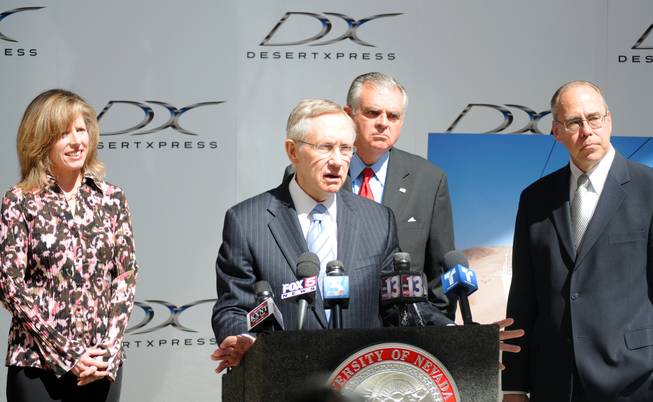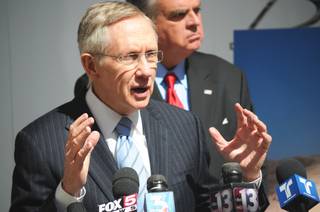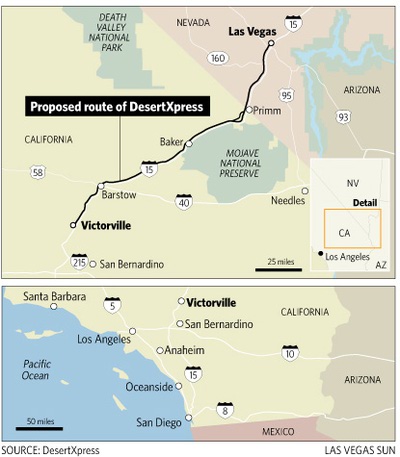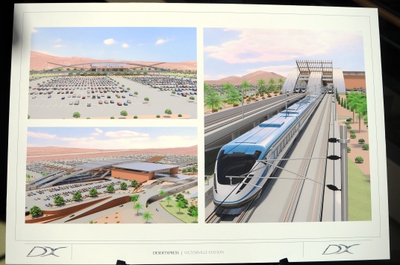
Sen. Harry Reid speaks to the media about progress on the DesertXpress high-speed rail project Friday, March 25, 2011, at the UNLV Science and Engineering building. With him, from left, is Nevada Department of Transportation Director Susan Martinovich, U.S. Secretary of Transportation Ray LaHood and UNLV President Neal Smatresk.
Friday, March 25, 2011 | 4:22 p.m.
Reader poll
KSNV: DesertXpress EIS
KSNV coverage of announced completion of environmental impact statement for DesertXpress high-speed rail project between Las Vegas and California, March 25, 2011.
Sun archives
- DesertXpress rail project going after tax dollars, after all (2-21-2011)
- DesertXpress top executive retires from high-speed rail project (12-17-2010)
- With new leaders, a revival of maglev high-speed rail? (11-25-2010)
- Harry Reid hopeful DesertXpress gets support from next governor (10-13-2010)
- Transportation secretary envisions nation connected by high-speed rail (10-13-2010)
- High-speed rail: Will it be worth the wait for Nevadans? (9-31-2010)
- DesertXpress likely further delayed by a federal agency (9-24-2010)
- Work on high-speed rail set to begin this year (3-25-2010)
- $45 million for maglev shifted to airport road project (3-17-2010)
- Backers of maglev train say Chinese bank prepared to fund project (2-3-2010)
- Maglev train backers woo contractors with promise of jobs (1-22-2010)
- DesertXpress prepared to build; maglev, monorail extension on hold (1-15-2010)
DesertXpress, a proposed $6 billion high-speed rail line that would link Las Vegas with Victorville, Calif., cleared another major hurdle Friday with the Federal Railroad Administration’s release of its final environmental report on the route.
Transportation Secretary Ray LaHood announced the completion of the environmental impact statement, a document that was reviewed by five federal agencies, during a press conference at UNLV’s Science and Engineering Building.
The announcement also included presentations by Sen. Harry Reid, Nevada Department of Transportation Director Susan Martinovich and UNLV President Neal Smatresk.
DesertXpress officials had expected the environmental report to be completed by the end of 2010 so the fact that was completed was no big surprise. But transportation experts say the announcement is significant because it is one of the first reports involving high-speed rail transportation, an important piece of President Obama’s transportation initiative.
An environmental report was completed for a high-speed rail line between Tampa and Orlando, but that project is in jeopardy because Florida Gov. Rick Scott in February rejected federal money for the line.
Reid, LaHood and Martinovich didn’t answer specific questions about the report because they hadn’t seen the document, which was posted by the FRA earlier today.
One of the key aspects of the report is the location of the Las Vegas train station. Experts familiar with the project say the preferred site for the station is at Russell Road and Interstate 15.
The draft environmental report also considered two sites at Flamingo Road and I-15 and one in downtown Las Vegas, but the Russell Road site is preferred because of the additional cost of continuing the line farther north.
Additional right-of-way would have to be acquired to run the track to Flamingo Road or downtown and tracks would have to be elevated.
The rest of the report outlines preferred routes of the dual tracks that would run 185 miles, primarily along the I-15 corridor between Las Vegas and Victorville. The report analyzed several alternative corridors on portions of the route with the objective of avoiding desert tortoise habitats and other environmentally sensitive areas.
While DesertXpress officials attended the event, they didn’t participate in the conference with LaHood, Reid, Martinovich and Smatresk.
After the conference, Andrew Mack, chief operating officer of DesertXpress Enterprises, explained how important completion of the report is.
“It’s really significant for DesertXpress because it means that the six years of hard work by the federal and state agencies has reached a conclusion and it sets the path forward for final permitting so we can start the project,” Mack said.
Mack said he’s still uncertain when the company will be able to break ground for the project, but Reid said during the press conference that he was hopeful that it would occur before the end of the year.
DesertXpress has applied for a $4.9 billion loan through the Railroad Rehabilitation & Improvement Financing program, which provides direct federal loans and loan guarantees to finance development of railroad infrastructure.
Under terms of the program, funding may be used to develop or establish new intermodal or railroad facilities and direct loans can fund up to 100 percent of a railroad project with repayment periods of up to 35 years and interest rates equal to the cost of borrowing to the government.
If approved, the loan would be more than four times the amount the program has loaned to 28 railroad projects that have received loans through RRIF program since 2002.
Since 2002, the program has lent $1.02 billion with the largest loan, $233 million, going to the Dakota, Minnesota & Eastern Railroad in 2003.
The FRA has hired an independent analyst to determine if ridership estimates, $50 one-way fares and other ancillary revenue will be enough to pay back the loan and prevent taxpayers from footing the bill.
LaHood and Reid had no update on the status of the loan request.
Mack said his company may not borrow the total amount in the request and has been awaiting the final environmental report to determine which route alternatives would be approved to determine a final cost of the project.
Transportation consultant Tom Skancke, who advises local government officials and the Las Vegas Convention and Visitors Authority about transportation matters, said today’s announcement “is a big victory in the transportation world.”
“It’s a big victory for the Obama administration’s vision of high-speed rail in the United States and a big victory for Sen. Reid in helping Nevada get the nation’s first high-speed rail transportation system,” Skancke said.
“This is also a great model as a classic public-private partnership,” he said. “Public-private partnerships often are criticized because companies seek up-front money for their projects. In this case, DesertXpress has invested a lot of their own money to get the environmental reports completed and are now going to the government with this loan request to build the project.”
Reid also said the project is important because of the jobs it would provide. He said DesertXpress would bring 35,000 jobs to Clark County alone with construction, operation as well as suppliers and vendors for the project. Several thousand more jobs are expected to be created in Southern California once the project begins.




Join the Discussion:
Check this out for a full explanation of our conversion to the LiveFyre commenting system and instructions on how to sign up for an account.
Full comments policy